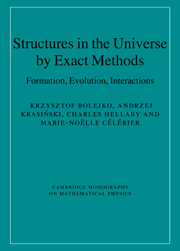Book contents
5 - The cosmological constant and coincidence problems
from II - APPLICATIONS OF THE MODELS IN COSMOLOGY
Published online by Cambridge University Press: 20 January 2010
Summary
Since its discovery during the late 1990s (Riess et al., 1998; Perlmutter et al., 1999), the dimming of distant SN Ia has been mostly ascribed to the influence of a mysterious dark energy component. Formulated in a Friedmannian framework, based upon the ‘cosmological principle’, this interpretation has given rise to the ‘Concordance’ model. However, we have already stressed in Chapter 1 that a caveat of such a reasoning is that the ‘cosmological principle’ derives from the philosophical Copernican assumption and has never been tested.
Moreover, it is well known, since the work of Ellis and Stoeger (1987), that the inhomogeneities observed in our Universe can have an effect upon the values of the cosmological parameters derived for a smoothed-out or averaged Friedmannian model. A tentative estimate of such an effect was computed by Hellaby (1988). He found that the error obtained when using averaging procedures compared to the volume matching (i.e. the procedure proposed by Ellis and Stoeger, 1987) of Friedmann models to inhomogeneous L–T solutions with realistic density profiles implies that the mean density and pressure of the averaged Friedmann models are 10–30% underestimated as regards the volume-matched ones. Therefore, even if the cosmological constant is the only component in the Einstein equations beyond ordinary matter, the estimation of its actual value is less straightforward than the conventional wisdom has it.
As regards dark energy, i.e. a negative pressure fluid with an equation of state parameter ω ≠ −1, (ω = −1 being the signature of the pure geometric cosmological constant), it remains a phenomenon which cannot be explained in the framework of current physics.
Information
- Type
- Chapter
- Information
- Structures in the Universe by Exact MethodsFormation, Evolution, Interactions, pp. 137 - 183Publisher: Cambridge University PressPrint publication year: 2009
